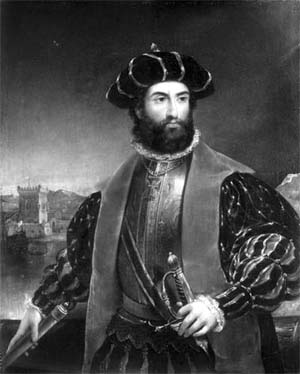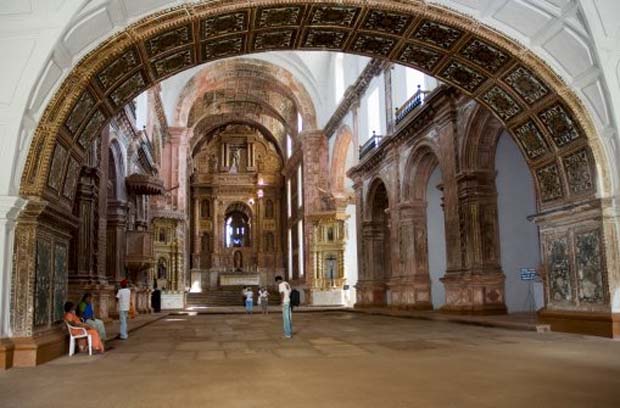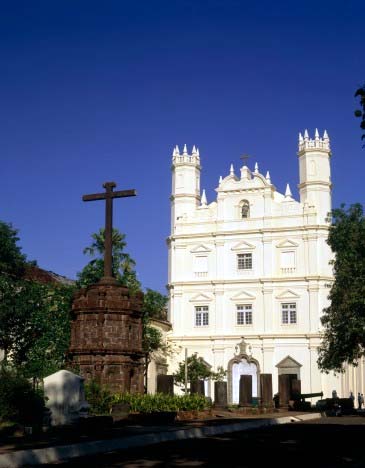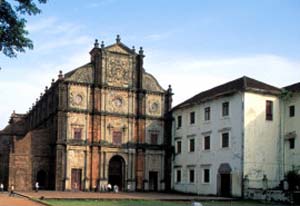Dec 17, 2025
Dec 17, 2025
The control of the Mediterranean by the Turks and the Egyptians, and their subsequent domination of cities in the Middle East holy to both Christianity and Islam, prompted the orthodox Portuguese kings to find a way to the Indies, both to menace the Muslims along another front as well as to supplement trade.
 1498 AD – Vasco da Gama was the first to round the Cape of Good Hope, South Africa, and, with the help of a Gujarati navigator, to eventually sail and drop anchor off the port of Calicut. In his log, Vasco da Gama records his first meeting, and answers to a query that he comes in search of ‘Christian and Spices’. In fact, the Portuguese first mistook the Hindu inhabitants of Calicut for Christians. In Vasco da Gama’s words: The city of Calicut is inhabited by Christians. They are of tawny complexion. Some of them have big beards and long hair, whilst others clip their hair short or shave the head, merely allowing a tuft to remain on the crown as a sign that they are Christians.
1498 AD – Vasco da Gama was the first to round the Cape of Good Hope, South Africa, and, with the help of a Gujarati navigator, to eventually sail and drop anchor off the port of Calicut. In his log, Vasco da Gama records his first meeting, and answers to a query that he comes in search of ‘Christian and Spices’. In fact, the Portuguese first mistook the Hindu inhabitants of Calicut for Christians. In Vasco da Gama’s words: The city of Calicut is inhabited by Christians. They are of tawny complexion. Some of them have big beards and long hair, whilst others clip their hair short or shave the head, merely allowing a tuft to remain on the crown as a sign that they are Christians.
This first encounter was the beginning of the Portuguese adventure with India which lasted till 1961, when the Indian Army took over Goa, Daman and Diu. In the 15th and 16th centuries, the Portuguese established trading bases all along the Malabar coast, and became an important political force in the hinterland. Their powerful naval fleet controlled commerce in the Indian Ocean and broke up the hegemony enjoyed till that point by Gujarat. The Portuguese would remain powerful till their domination was broken by two events – the defeat and subsequent vassal status of Portugal itself by the Spanish, and the arrival of other European powers, namely the French, the English and the Dutch in the Indian Ocean.
This did not mean, however, that the Portuguese culture has not contributed substantially to the region. The Portuguese did not take their women with them when they travelled across the sea; and so to maintain the small garrisons in India, the sailors were encouraged to marry Indians and this phenomenon gave birth to another class of mixed blood people who were Christians and spoke Portuguese, but in many ways retained the culture and customs of their maternal ancestors.
Goa also became cosmopolitan – its status as a trading centre attracted people from all over India and at one time the university had students from all over the subcontinent speaking 18 different languages, and the printing presses were amongst the first to print in vernacular. The Jesuits were asked to send two representatives to Akbar’s discussions on various religions that were taking place contemporaneously at Fatehpur Sikri.
The architecture of the imperial Portuguese presence is marked by its many churches and cathedrals, which faithfully document in their turn European post-Renaissance architecture, though to Classicism and its Mannerist and Baroque branches. There also still exist old mansions, dating mainly from the 18th century, as well as numerous remains of fortifications and defences, but in the main it is Portuguese churches and monastic buildings which take pride of place.
Although Goa is dotted with white churches, the chief colonial architecture representatives are the Cathedral of St. Catherine (Se Cathedral), (founded 1562, rebuilt from 1631), the Church of the Holy Spirit or St. Francis of Assisi (1521), the Bom Jesus (1594), and the Church of Our Lady of Divine Providence, from 1665.

 In this way the Church of the Holy Spirit or St. Francis of Assisi shows evidence of the Manueline* style in its entrance portal, and its façade in its repetition of plastered bays seems to be inspired from the early Renaissance. The plan of the church is not an exaggerated cross, conforming to the requirements of Christian ceremony at the time incorporating strong counter-reformist (against Protestants) Jesuit influences.
In this way the Church of the Holy Spirit or St. Francis of Assisi shows evidence of the Manueline* style in its entrance portal, and its façade in its repetition of plastered bays seems to be inspired from the early Renaissance. The plan of the church is not an exaggerated cross, conforming to the requirements of Christian ceremony at the time incorporating strong counter-reformist (against Protestants) Jesuit influences.  The rich façade of the Bom Jesus incorporates much leathery scroll-work and oddly proportioned pilasters at variance with the canonical four-storey sequence from Doric at the base to Composite at the top. This cathedral is also famous for housing the mortal remains of St. Francis Xavier, whose extremely floral tomb rests in one niche of the building.
The rich façade of the Bom Jesus incorporates much leathery scroll-work and oddly proportioned pilasters at variance with the canonical four-storey sequence from Doric at the base to Composite at the top. This cathedral is also famous for housing the mortal remains of St. Francis Xavier, whose extremely floral tomb rests in one niche of the building.
23-May-2004
More by : Ashish Nangia